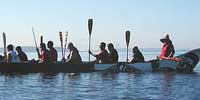Tribal Journey
Parts One  7:12 &
Two
7:12 &
Two  7:10
Jesse Boggs
7:10
Jesse Boggs
A two-part profile of the Canoe Nations of the Northwest.
Broadcast: Sep 17 & 24 2005 on APM Weekend AmericaSeries: Tribal Journey Subjects: Native, Travel, Historical
For thousands of years, tribal cultures fished, hunted, traded, made alliances, fought wars, and generally thrived along the shores of the Pacific Northwest, from the Aleutian Islands in Alaska down through Puget Sound to the Oregon Coast. In skin-boat kayaks and great ocean-going canoes they navigated some of the most turbulent waters on the planet.
Forests of the world's largest trees blanketed the southern reaches of this territory. Here the Suquamish, Tlingit, Sklallam and other tribes carved fifty-foot canoes, each crafted from a single cedar trunk and adorned with mythical figures. A dozen paddlers powered a great canoe. They were the eighteen-wheelers, the troop trains, the limousines of that place and time. They carried trade goods, dignitaries, warriors and adventurers throughout the tribal realms.
Further north, along the Aleutian Island chain, no trees grew. The only wood available to the Aleut tribes was driftwood that washed ashore from the Bering Sea. So the people lashed pieces of wood together and stretched sea lion skins over the frames. Aleutian skin-boats were the first sea kayaks -- fast, maneuverable, and so seaworthy that the Aleuts paddled them across hundreds of miles of open ocean. When fur traders from Europe and Russia showed up in the 18th Century, they regarded skin-boats as they finest craft they'd ever seen. The Russians called them "baidarkas."
Throughout the 18th, 19th and 20th centuries, waves of traders and settlers descended on the Pacific Northwest. Enslaved, reduced by disease, overwhelmed by sheer numbers, the tribal cultures had virtually disappeared by the middle of the 20th Century. Traditional skills that had been passed on orally for generations, including boat-building, were lost. The Great Canoes and skin-boat kayaks were relegated to museums and a few obscure history books.
But now they're back. Thanks to the dedication of a handful of researchers and craftsmen, the boat-building traditions of the Pacific Northwest have been reclaimed. With them have come long-lost songs, prayers and ceremonies. Since the 1990s, growing numbers of Great Canoes, this past year joined by Aleut kayaks, have made the annual "Tribal Journey" through Puget Sound. The event lasts two or three weeks, hosted each year by a different village. The host village is the ultimate destination. The Journey is a ceremony, a celebration, and a reclamation of language, songs and traditions. The fleet travels from village to village along the coastal waters of Canada and Washington state, gathering more canoes and paddlers as they go. At each village the travelers are met by hundreds, and eventually thousands, of supporters. Tent cities rise up each evening, a feast is prepared, tribes present dances and songs, and preparations are made for the next day's leg of the Journey.
The return of the great canoes and skin-boat kayaks is a triumph of the human spirit. With every stroke of their paddles, the people of the Pacific Northwest draw away from the despair that has haunted them for generations. They draw closer to each other and to their ancestors. They pull away from disease, drugs, alcohol and obesity, towards traditions that promote health, dignity and self-respect. And they demonstrate to all of us what can be accomplished when people pull together in common cause.
|
corporation for public broadcasting |
national endowment for the arts |
hearing voices |


